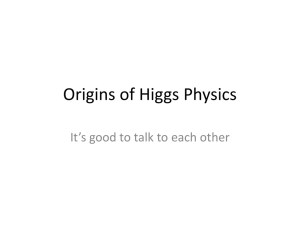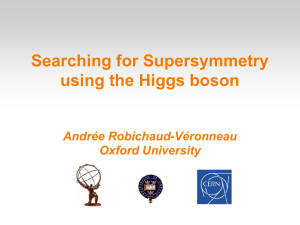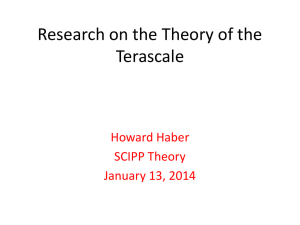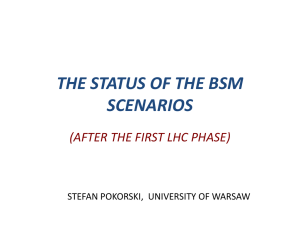Masterclasses VIDEO CONFERENCE MANUAL ATLAS Z
advertisement
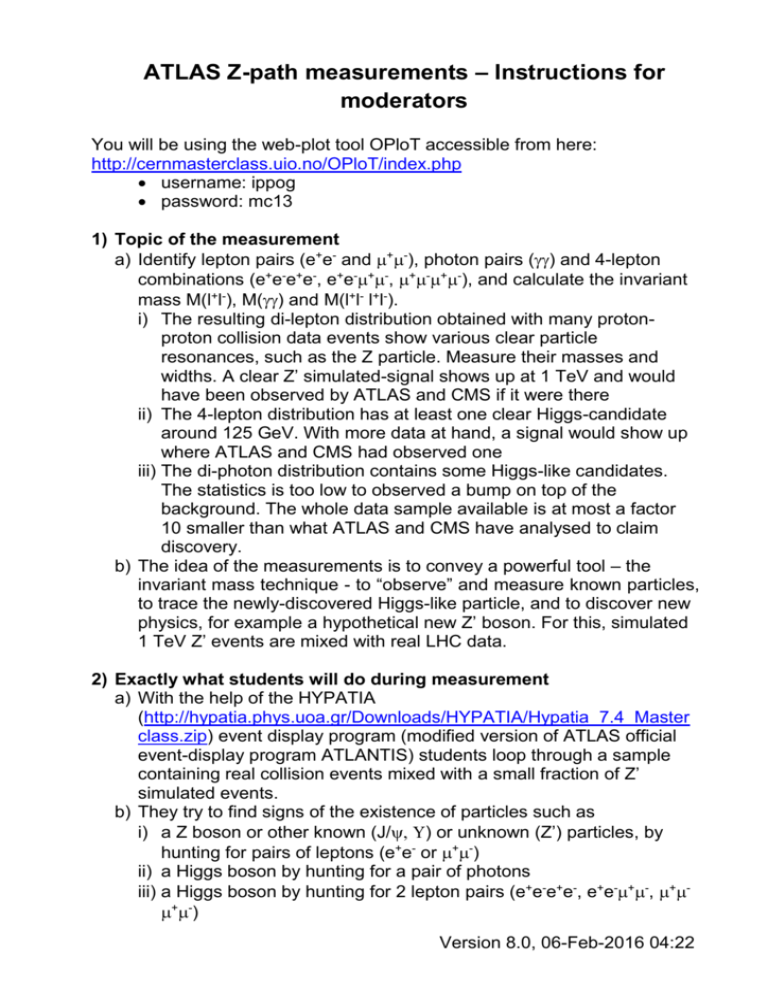
ATLAS Z-path measurements – Instructions for moderators You will be using the web-plot tool OPloT accessible from here: http://cernmasterclass.uio.no/OPloT/index.php username: ippog password: mc13 1) Topic of the measurement a) Identify lepton pairs (e+e- and +-), photon pairs () and 4-lepton combinations (e+e-e+e-, e+e-+-, +-+-), and calculate the invariant mass M(l+l-), M() and M(l+l- l+l-). i) The resulting di-lepton distribution obtained with many protonproton collision data events show various clear particle resonances, such as the Z particle. Measure their masses and widths. A clear Z’ simulated-signal shows up at 1 TeV and would have been observed by ATLAS and CMS if it were there ii) The 4-lepton distribution has at least one clear Higgs-candidate around 125 GeV. With more data at hand, a signal would show up where ATLAS and CMS had observed one iii) The di-photon distribution contains some Higgs-like candidates. The statistics is too low to observed a bump on top of the background. The whole data sample available is at most a factor 10 smaller than what ATLAS and CMS have analysed to claim discovery. b) The idea of the measurements is to convey a powerful tool – the invariant mass technique - to “observe” and measure known particles, to trace the newly-discovered Higgs-like particle, and to discover new physics, for example a hypothetical new Z’ boson. For this, simulated 1 TeV Z’ events are mixed with real LHC data. 2) Exactly what students will do during measurement a) With the help of the HYPATIA (http://hypatia.phys.uoa.gr/Downloads/HYPATIA/Hypatia_7.4_Master class.zip) event display program (modified version of ATLAS official event-display program ATLANTIS) students loop through a sample containing real collision events mixed with a small fraction of Z’ simulated events. b) They try to find signs of the existence of particles such as i) a Z boson or other known (J/ ) or unknown (Z’) particles, by hunting for pairs of leptons (e+e- or +-) ii) a Higgs boson by hunting for a pair of photons iii) a Higgs boson by hunting for 2 lepton pairs (e+e-e+e-, e+e-+-, ++-) Version 8.0, 06-Feb-2016 04:22 Masterclasses VIDEO CONFERENCE MANUAL c) They pick the corresponding tracks or physics objects and insert them into the HYPATIA invariant mass table. d) They finally upload the invariant mass file they have made into the web-based plotting tool – OPloT (http://cernmasterclass.uio.no/). 3) Datasets used: ATLAS real pp-data from 2012 at 8 TeV a) Di-leptons, ~20.000 events i) Di-electrons and di-muons from Z (mainly), Jand ii) 2000 fully simulated Z’ events (mass 1 TeV) b) Higgs Candidates: real data events corresponding to 2fb-1 i) Di-photons: 12.000 events ( cuts as in ATLAS publication – including converted photons) c) 4 leptons: 40 events i) Cuts as in ATLAS publication 4) Results the students will come up with a) 3 invariant mass plots combined for the institute. Each student analyses 50 events, containing roughly 50% Z particles (into dileptons), 35% containing Higgs candidates (30% into and 5% into 4 leptons), as well as smaller fractions of J/(5%), (5%) and Z’ (5%) (into di-leptons) b) The main result are the invariant mass plots and the resonances they contain (or may contain) c) The students will have observed that various resonances are more visible in the combined invariant mass plot from the whole institute compared to their 50 events. i) The students will have compared the proportion of e+e- and +ii) The students will be aware that they have measured important properties of some particles: mass and width, both given by OPloT d) The students will have tracked the Higgs particle as ATLAS did in 2 photons and 4 leptons. i) They should be aware that they worked with real Higgs candidates which they had “at hand” ii) They will have realized this by adding some simulated Higgs signal events to the measured combined invariant mass distributions of 2 photons and 4 leptons using OPloT iii) They will also have learned that the event statistics at hand is too low to clearly discover the new particle themselves, as ATLAS and CMS did on July 4th 2012. 2/8 Masterclasses VIDEO CONFERENCE MANUAL 5) Institutes will present their combination plot Most of the material must have been discussed at the institute level. a) They might comment on the various particles they have observed in the di-lepton plot (J/, , Z and Z’), identified by their mass (~3 GeV, ~10 GeV, ~90 GeV and ~1000 GeV, respectively) and their widths. (The mean values are indicated in the legend of the plot) b) They might comment on the e+e- and +- composition of the dilepton plot. (It could be that electrons are more difficult to recognize than muons). c) They might comment that there are some entries between the resonances. (This background is due to combinations of leptons not coming from resonances. The lepton might also be incorrectly assigned as such; for example photons can be misidentified as electrons. d) They might comment on the Z’ peak and remind that it is a simulated signal of a hypothetical brother of the Z which is predicted by some theories proposed to unify all fundamental forces. e) They might question the Higgs measurement and comment on the difficulty to conclude whether they have observed the Higgs or not, see discussion in point 8 below. f) They may claim that they have observed a Higgs candidate in the 4 lepton channel. Congratulations! i) Congratulate the students to have almost succeeded in observing the Higgs in the di-photon channel ii) With 10 times more statistics they would have reproduced the July 4th revolution! iii) However, it takes a long time to go through very large number of events. Without the worldwide Grid, it would have taken ATLAS and CMS many years to digest the data and results g) Institutes leaders may use the slides where the ATLAS measurement and the combined student measurements are put side by side, these are an extended version of the slides that you can also use – see point 7e below 6) Link to moderator’s “access-point” for discussion, namely the OPloT web-interface: http://cernmasterclass.uio.no (click on OPloT at the top to enter the plotting tool) a) username: ippog b) password: mc13 3/8 Masterclasses VIDEO CONFERENCE MANUAL 7) Moderators will access the “Moderator” page on the OPloT-webinterface a) Click on the “Moderator” menu-item on Start-page b) Choose the right year-month-day in the three drop-down menus c) Click on "Combination plot - all institutes" for the total combination of all the institutes participating that day d) A set of plots will appear, which is the combination of all groups’ results e) Moderators may use the slide(s) where the ATLAS measurements and the combined student measurements are put side by side – click on link: “Slides comparing IMC2014 with official ATLAS Results“ on the Moderator page in OPloT - slide 2 is most relevant In the following, some examples of combined plots obtained using half of the available sample of events (corresponding to 1fb-1) are commented. The first figure below shows the 3 invariant mass distributions (“ll+4l+overview” chosen as “Plot type”). Number of bins can be changed. In the plot below, only the “ll” type is chosen. Note that logarithm scale is used for the x-axis in order to clearly see 4 resonances simultaneously: J/ (~3 GeV), (~10 GeV), Z(~90 GeV), and Z’(~1000 GeV). The table to the right summarises the results (mass and width) of the 4 particles corresponding to the 4 regions R1-4. Final states with electrons (upper table) and with muons (lower table) can be compared. 4/8 Masterclasses VIDEO CONFERENCE MANUAL Next, the invariant mass of 4 leptons is shown below – plot type “4l” chosen. In addition to the “Student distribution”, three coloured “Higgs MC” distributions are added for three luminosities (2fb-1, 10fb-1 and 25 fb-1), showing how many Higgs events are expected assuming the Higgs mass to be 125 GeV. A comment: there are too few 4-lepton events and identical events are analysed by many students. In the combination 4-lepton plots, however, the duplicates are removed. By choosing “Expected distribution” the expected distribution will be shown and not the results of the students’ measurements. 5/8 Masterclasses VIDEO CONFERENCE MANUAL Finally, the invariant mass of 2 photons is given below – plot type “” chosen. The distribution obtained by the students is in blue. Also shown are the expected simulated background (green) and 125 GeV Higgs signal (red) corresponding to an integrated luminosity of 1.03fb-1 (“1.03fb-1” is ticked). Chose “2 fb-1” for the 2014 Z-path results. Note that in this plot only half of the available data in 2014 is used. The “Student Distribution” therefore fits very well to the 1fb-1 of simulated data. If all 2014 data had been used, the blue (student) distribution would be close to the green background MC for 2fb-1. The goal of these comparisons is to show that given the high background, compared to the tiny Higgs signal, 1fb-1 (or 2fb-1 for that matter) of data is not enough to disentangle the signal from the background. More data is needed to claim discovery. To claim discovery ATLAS analysed more than 25fb-1 of data. The next figure demonstrates that with 25fb-1, for example, a clear signal singles out on top of a smooth exponential background. 6/8 Masterclasses VIDEO CONFERENCE MANUAL 8) Keywords for discussion Most of the items below should first have been discussed at the institute level. Di-lepton measurement a) Compare the histograms of the e+e- or +- pairs. i) Point out differences/similarities? ii) How often does the Z boson decay into e+e-? How often does the decay result in +-? iii) What was expected? Why? b) Any notice of other particles? At which invariant masses? c) What is the most probable mass of the Z boson? i) Why is there not one exact value for the Z boson mass? ii) What could be the possible explanations of why the distribution is so wide? d) Any sign of the Z' boson? i) If yes, what is the Z' boson's mass? e) Why is it useful to combine your results with those obtained by other groups? Di-photon measurement f) Any sign of Higgs decaying to 2 photons, H→? i) If not, what could be the reasons? g) In fact the full sample does contain some real Higgs candidates at a mass of ~125 GeV, even if it is not possible to tell exactly which ones they are! 4-lepton measurement h) Any sign of Higgs decaying to 4 leptons, H→ZZ→llll? i) If not, what could be the reasons? i) In fact the whole sample contains at least one Higgs candidate. At which mass? General discussion j) How do the individual institute-plots look compared to the combined plot of the day? i) More data (obviously) ii) Have the widths of the observed particles gotten smaller? (The width is a property of a particle and should not change too much with much higher statistics). iii) Comment on the strength of combining data, that for example 7/8 Masterclasses VIDEO CONFERENCE MANUAL possible mistakes by single analyzers – the students – become relatively less important k) Why does the combination not help much in the case of the Higgs search? i) Comment that the process HZZ4l is really rare. Students have been looking at the same small number of candidates (~40 in total). ii) Comment that the 2 fb-1 statistics is not enough for the Higgs signal to appear clearly on top of the much larger background from other Standard Model processes. Be prepared to show the simulation comparison between 2fb-1 and 25fb-1 provided for this purpose 8/8

